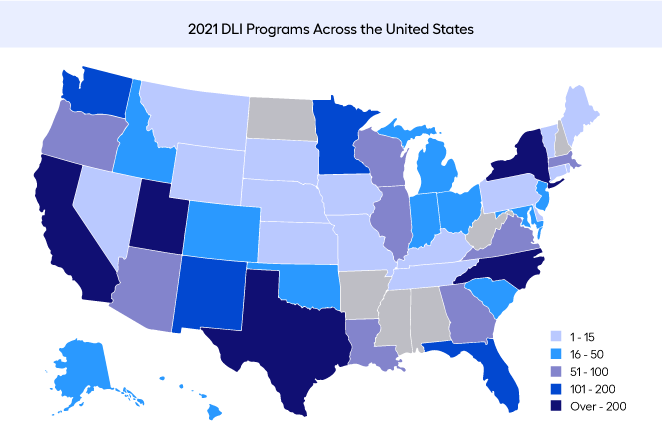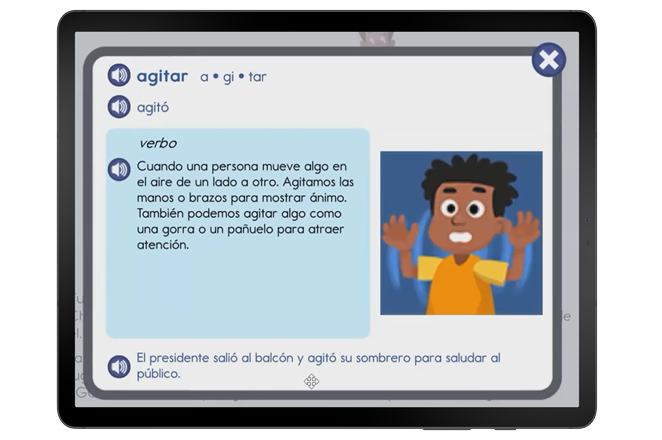June 28, 2023 2:09 pm
The Science of Learning a Second Language
Learning a new language is not easy. Trading outdated instruction for science of reading-backed techniques can help give English language learners the skills they need for biliteracy.
“English is HARD.”
This was my students’ (and my) mantra whenever we encountered something about the language that just didn’t make sense. I was teaching English language development, or ELD, for newcomers in grades 9–12, most of whom were native Spanish speakers.
As anyone who’s taken a language class in high school or college knows, it gets more difficult to learn a language the older you get. That’s what I always assumed was the reason behind my students’ struggle to acquire English. That, and the fact that I agreed that English is “HARD.”
Without a background in linguistics (and as a first-year teacher), I couldn’t quite explain why it was hard, though. I just knew there were exceptions to every rule I taught.
But 10 years later, the science of reading is helping me understand — both why it was so challenging for my students and what kind of instruction would have helped them. The science of reading is “the converging evidence of what matters and what works in literacy instruction, organized around models that describe how and why.” Research tells us that systematic instruction in phonological awareness, phonics, and vocabulary, combined with fluency and comprehension is what builds foundational literacy skills and sets students up for a lifetime of reading success.
Here are 3 ways the science of reading can help improve instruction for ELs:
What I did:
Encouraged (okay, begged) my students to only speak English in the classroom
My district’s ELD curriculum recommended only allowing students to speak English in the classroom. Though I knew it would be a tough sell, I found some merit to it. If there were students with different native languages, English became the unifying language in the class — keeping students from feeling excluded. And the more you immerse yourself in a language, the faster you learn it.
Why that didn’t work:
At any given point, 90 to 100% of my students were from Spanish-speaking backgrounds, and that was how they communicated with each other — regardless of how convincing I thought I was. As teenagers feeling singled out in remedial ELD classes at a high school in a new country, it made sense that they defaulted to the language they felt comfortable speaking.
But the main reason this didn’t work wasn’t because of their noncompliance. It was because what made learning English especially hard for my students was a lack of literacy skills in any language. Inconsistent schooling led to their Spanish reading and writing skills being far below grade level.
1
What the science tells us: language skills transfer from one language to another
In my professional development for the ELD curriculum, the trainers assured teachers that a student’s proficiency in their first language had no bearing on their ability to learn English. Though that felt wrong to me, I didn’t have the confidence to question it as a new teacher. We now know this isn’t accurate.
Because research shows that students use the same sound/letter correspondence skills within and across languages, we can assume that their ability to map letters with sounds transfers from literacy instruction in one language to another. So, while the intention to focus on acquiring English via complete immersion was logical, it was unrealistic for my students who needed a basic foundation of language skills in their first language. Without that, learning another language would require more than just avoiding Spanish (actually, quite the opposite).
What I did:
Focused on grammar over vocabulary. My grammar-based direct instruction curriculum emphasized understanding the structure and syntax of English over the meanings of individual words. I was teaching my students to identify the parts of speech of words they didn’t know based on their placement in a sentence they also didn’t understand. It was frustrating for all of us.
Why that didn’t work:
When you’re first learning a new language, you naturally gravitate to the words and phrases that are important to you. If you’re traveling, “please” and “thank you” are useful. If you are learning a new style of cooking, you’ll want to learn the names of foods. And if you’re a baby, your first word will be the most important object in your world (usually ‘dada’ or ‘mama,’ or in my son’s case, ‘panda’). Once you learn those words, you can then build the understanding needed to notice how they are placed in a sentence.
My students showed me this as they repeatedly asked me what words meant, while I unsuccessfully tried to reroute them back to the grammar concept we were learning. Finally, I gave in and started “What does it mean” Wednesdays. They collected English words and phrases they encountered in their daily lives — at work, on the bus, at the doctor’s office — and we spent 30 minutes crowdsourcing the definitions. This was easily the most engaged my students were all week — because it mattered to them.
2
What the science tells us: vocabulary supports comprehension and fluency, especially when incorporating syntax instruction
In other words, if grammar and syntax are the structure of language, vocabulary is the building blocks. This is not to say we should throw out grammar instruction entirely (though students might celebrate). Evidence shows that increasing vocabulary boosts students’ reading comprehension and fluency, requiring less decoding and allowing them to read for meaning. But when you combine that vocabulary practice with explicit syntax instruction, emerging bilinguals show increased comprehension — able to unlock meaning not just from the words themselves but also from how they are organized in the sentence.
What I did:
Practiced English letter sounds individually. During our daily language warm-up, we practiced “saying” a few different letters at a time. Without much more direction than that in the teacher’s guide, this was challenging. When faced with the letter “a,” it seemed like I discovered another pronunciation with each practice attempt. There are the long and short sounds like “make” and “cat,” of course, but then also “want” and “many.”
Why that didn’t work:
Decoding demands are different in English and Spanish. Focusing on single letter sounds in English was confusing for my students whose first language was Spanish. That’s because Spanish is a phonetically regular language, with 27 letters mapping to 22-24 phonemes, while English, with 26 letters and 44 possible phonemes, is not. Native Spanish speakers expect the letters to make the same sounds wherever they are placed in a word, and that’s just not the case.
3
What the science tells us: English requires more intense explicit phonemic awareness
Learning to read in Spanish requires an emphasis on syllable awareness. In fact, once students learn the basic sound-symbol correspondences, they can easily decode and read most Spanish words with a high degree of accuracy. But in English, phonemic awareness is crucial — especially when coming from a language where sounds and letters make more “sense.” Activities like rhyming, segmentation, and blending help students to understand all the different sounds English letters can make, by themselves and when combined with others.
While it’s hard to look back at all the things I should have done differently as a teacher, it’s promising to know that first-year language arts teachers now will start teaching with all of my science of reading hindsight as their basis of instruction. But I would still love to travel back in time and give my students exactly what they needed: English language instruction grounded in the science of reading combined with high-quality Spanish language arts (SLA) to reinforce literacy in their first language. Maybe then our class mantra could have been more like “English is hard, but we have the skills and support to learn it.” (Even if the last part was just in my head because high schoolers would never say that.)
About the Author – Ally Jones
Ally Jones is a California credentialed educator who specialized in teaching English language learners at the secondary level. Outside of education, she is passionate about fitness, literature, and taking care of the planet for her son’s generation.
The Science of Reading Applied
Imagine Learning’s solutions make it easier for teachers to apply the research.





